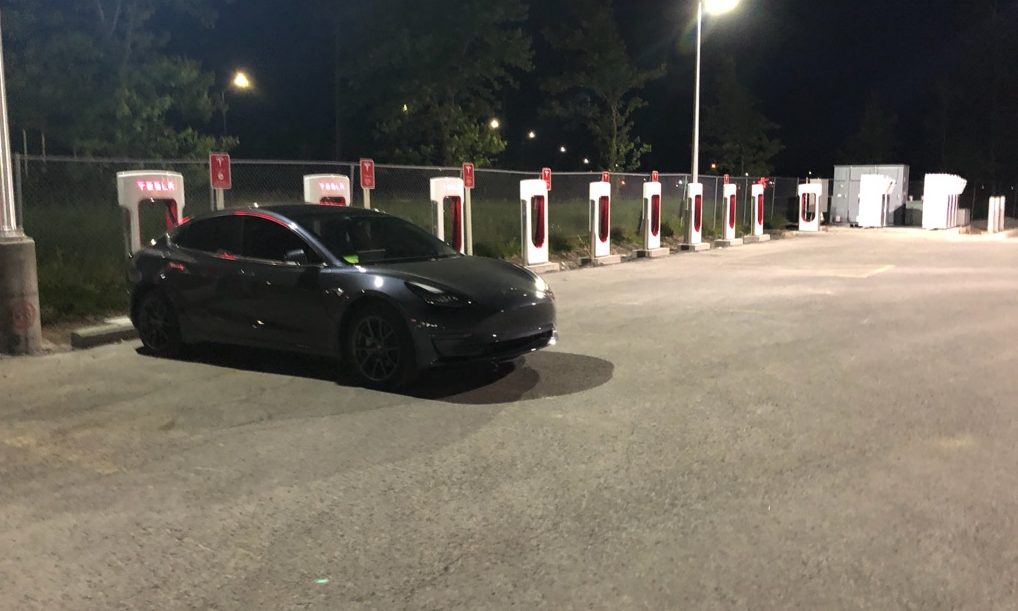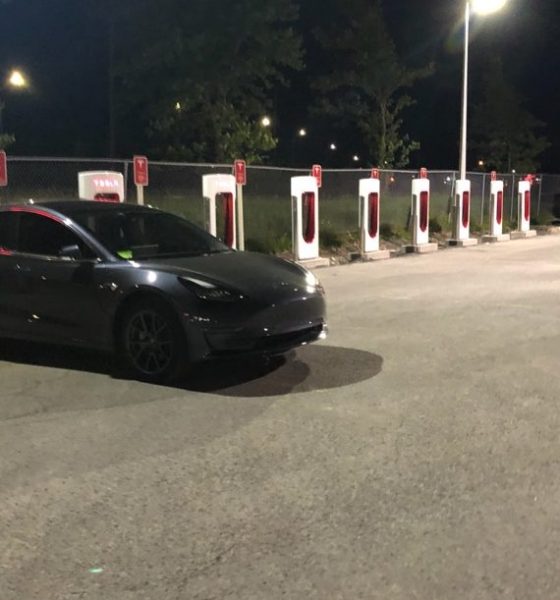

News
Tesla’s next Easter Egg will greet car vandals with Bach and Beethoven
Tesla CEO Eon Musk revealed additional details on how the company’s upcoming Sentry Mode theft-deterrent system will function, which includes a humorous look against the background of something as serious as addressing vehicle break-ins. According to Musk’s latest Tweet about the Iron Man-reminiscent feature, when an intrusion is detected while Sentry Mode is activated, composer Johann Sebastian Bach’s Toccata and Fugue in D minor, BWV 565 will play, drawing as much attention as possible to the would-be perpetrator(s). Tesla’s combined commitment to its customers’ safety, security, and more-cowbells-fun is something frequently on display, and this amusing spin on a vehicle alarm system is no different.
But, occasionally, the metal versionhttps://t.co/ogHYUPoA9z
— Elon Musk (@elonmusk) January 27, 2019
Also added to the playlist about tactical intruder mitigation was a heavy metal version of the same 18th-century composer’s masterpiece. As with many of Musk’s Twitter rounds, the Tesla CEO was open to further suggestions and responded accordingly. An appropriately metal version of Beethoven’s Moonlight Sonata was proposed by NicheGamer, to which the Tesla executive agreed to include with the upcoming over-the-air software update. Of course, this isn’t the first time a Tesla has been involved in epic heavy metal music with a classical flair. The Model X features a holiday-themed Easter Egg wherein an entertaining light and winged-door show to the song “Wizards in Winter” by Trans Siberian Orchestra is enacted.
Sentry Mode was first revealed by Musk in a tweet-response to a Tesla owner complaint about a dent found in his car made while the vehicle was parked. While the car manufacturer has been rolling out security improvements over the last few months, including an in-car dash cam system and motion-sensing Enhanced Anti-Theft system, this latest reveal was seemingly in response to the most recent rise in Tesla-targeted thefts popping up all over social media and Internet forums. A few days later, Musk estimated that a ‘rough beta’ would be released in 2 to 3 weeks. While specific official details of the Sentry Mode feature are slim, one of the assumed components is an enhanced use of vehicles’ built-in dashcam, itself developed in response to issues of theft and hit-and-run incidents. The array of sensors and cameras which provide 360-degree visibility on Tesla vehicles equipped with the hardware were leveraged to provide the cam feature in the Version 9.0 software updated in September 2018.
Rough beta in 2 to 3 weeks
— Elon Musk (@elonmusk) January 25, 2019
When Elon Musk takes to Twitter to discuss new product ideas and features, it may not always be clear whether he’s serious, but it’s always amusing to imagine that he is and more often than not a safe bet to take. After all, The Boring Company (TBC), now poised to take on the traditional underground public transportation construction industry, infamously began with a tweet about “soul crushing” traffic. Considering the rapid expansion into TBC merchandising and positive response therefrom – hats, not-a-flamethrowers, etc. – the trend of tweets-turned-tangibles only has reasons to continue.
In the realm of new software features and Easter Eggs, anything Musk says is probably game for reality once Emissions Testing Mode (ETM) went live in a December 2018 software update. After teasing an upcoming “Toilet Humor” feature via Twitter, Tesla drivers saw the tease-promise kept via ETM which gives the option of directing fart noises to emit from a designated seat in the vehicle. In a tweet that sounds like it came from Musk himself, the official Tesla Twitter account recently pointed out that Romance Mode, the fireplace playing, heater-blasting, mood music setting fun feature released at the same time as ETM, “accommodates up to 5” in the Model 3. Whatever that means. Or doesn’t mean.
Altogether, Sentry Mode probably suggests it’s going to be horns-up for anyone nearby while a would-be robber tests out a Tesla vehicle’s proneness to theft. Either that, or anyone subjected to any intrusion detection system’s misidentifications won’t be so annoyed. (See: obnoxious car alarms that don’t quit.) Oh, and as for keeping Summer safe? Let’s hope things don’t come to that. Auto insurance is pricey enough.

Elon Musk
Elon Musk and Tesla AI Director share insights after empty driver seat Robotaxi rides
The executives’ unoccupied tests hint at the rapid progress of Tesla’s unsupervised Robotaxi efforts.

Tesla CEO Elon Musk and AI Director Ashok Elluswamy celebrated Christmas Eve by sharing personal experiences with Robotaxi vehicles that had no safety monitor or occupant in the driver’s seat. Musk described the system’s “perfect driving” around Austin, while Elluswamy posted video from the back seat, calling it “an amazing experience.”
The executives’ unoccupied tests hint at the rapid progress of Tesla’s unsupervised Robotaxi efforts.
Elon and Ashok’s firsthand Robotaxi insights
Prior to Musk and the Tesla AI Director’s posts, sightings of unmanned Teslas navigating public roads were widely shared on social media. One such vehicle was spotted in Austin, Texas, which Elon Musk acknowleged by stating that “Testing is underway with no occupants in the car.”
Based on his Christmas Eve post, Musk seemed to have tested an unmanned Tesla himself. “A Tesla with no safety monitor in the car and me sitting in the passenger seat took me all around Austin on Sunday with perfect driving,” Musk wrote in his post.
Elluswamy responded with a 2-minute video showing himself in the rear of an unmanned Tesla. The video featured the vehicle’s empty front seats, as well as its smooth handling through real-world traffic. He captioned his video with the words, “It’s an amazing experience!”
Towards Unsupervised operations
During an xAI Hackathon earlier this month, Elon Musk mentioned that Tesla owed be removing Safety Monitors from its Robotaxis in Austin in just three weeks. “Unsupervised is pretty much solved at this point. So there will be Tesla Robotaxis operating in Austin with no one in them. Not even anyone in the passenger seat in about three weeks,” he said. Musk echoed similar estimates at the 2025 Annual Shareholder Meeting and the Q3 2025 earnings call.
Considering the insights that were posted Musk and Elluswamy, it does appear that Tesla is working hard towards operating its Robotaxis with no safety monitors. This is quite impressive considering that the service was launched just earlier this year.
Elon Musk
Starlink passes 9 million active customers just weeks after hitting 8 million
The milestone highlights the accelerating growth of Starlink, which has now been adding over 20,000 new users per day.

SpaceX’s Starlink satellite internet service has continued its rapid global expansion, surpassing 9 million active customers just weeks after crossing the 8 million mark.
The milestone highlights the accelerating growth of Starlink, which has now been adding over 20,000 new users per day.
9 million customers
In a post on X, SpaceX stated that Starlink now serves over 9 million active users across 155 countries, territories, and markets. The company reached 8 million customers in early November, meaning it added roughly 1 million subscribers in under seven weeks, or about 21,275 new users on average per day.
“Starlink is connecting more than 9M active customers with high-speed internet across 155 countries, territories, and many other markets,” Starlink wrote in a post on its official X account. SpaceX President Gwynne Shotwell also celebrated the milestone on X. “A huge thank you to all of our customers and congrats to the Starlink team for such an incredible product,” she wrote.
That growth rate reflects both rising demand for broadband in underserved regions and Starlink’s expanding satellite constellation, which now includes more than 9,000 low-Earth-orbit satellites designed to deliver high-speed, low-latency internet worldwide.
Starlink’s momentum
Starlink’s momentum has been building up. SpaceX reported 4.6 million Starlink customers in December 2024, followed by 7 million by August 2025, and 8 million customers in November. Independent data also suggests Starlink usage is rising sharply, with Cloudflare reporting that global web traffic from Starlink users more than doubled in 2025, as noted in an Insider report.
Starlink’s momentum is increasingly tied to SpaceX’s broader financial outlook. Elon Musk has said the satellite network is “by far” the company’s largest revenue driver, and reports suggest SpaceX may be positioning itself for an initial public offering as soon as next year, with valuations estimated as high as $1.5 trillion. Musk has also suggested in the past that Starlink could have its own IPO in the future.
News
NVIDIA Director of Robotics: Tesla FSD v14 is the first AI to pass the “Physical Turing Test”
After testing FSD v14, Fan stated that his experience with FSD felt magical at first, but it soon started to feel like a routine.

NVIDIA Director of Robotics Jim Fan has praised Tesla’s Full Self-Driving (Supervised) v14 as the first AI to pass what he described as a “Physical Turing Test.”
After testing FSD v14, Fan stated that his experience with FSD felt magical at first, but it soon started to feel like a routine. And just like smartphones today, removing it now would “actively hurt.”
Jim Fan’s hands-on FSD v14 impressions
Fan, a leading researcher in embodied AI who is currently solving Physical AI at NVIDIA and spearheading the company’s Project GR00T initiative, noted that he actually was late to the Tesla game. He was, however, one of the first to try out FSD v14.
“I was very late to own a Tesla but among the earliest to try out FSD v14. It’s perhaps the first time I experience an AI that passes the Physical Turing Test: after a long day at work, you press a button, lay back, and couldn’t tell if a neural net or a human drove you home,” Fan wrote in a post on X.
Fan added: “Despite knowing exactly how robot learning works, I still find it magical watching the steering wheel turn by itself. First it feels surreal, next it becomes routine. Then, like the smartphone, taking it away actively hurts. This is how humanity gets rewired and glued to god-like technologies.”
The Physical Turing Test
The original Turing Test was conceived by Alan Turing in 1950, and it was aimed at determining if a machine could exhibit behavior that is equivalent to or indistinguishable from a human. By focusing on text-based conversations, the original Turing Test set a high bar for natural language processing and machine learning.
This test has been passed by today’s large language models. However, the capability to converse in a humanlike manner is a completely different challenge from performing real-world problem-solving or physical interactions. Thus, Fan introduced the Physical Turing Test, which challenges AI systems to demonstrate intelligence through physical actions.
Based on Fan’s comments, Tesla has demonstrated these intelligent physical actions with FSD v14. Elon Musk agreed with the NVIDIA executive, stating in a post on X that with FSD v14, “you can sense the sentience maturing.” Musk also praised Tesla AI, calling it the best “real-world AI” today.








